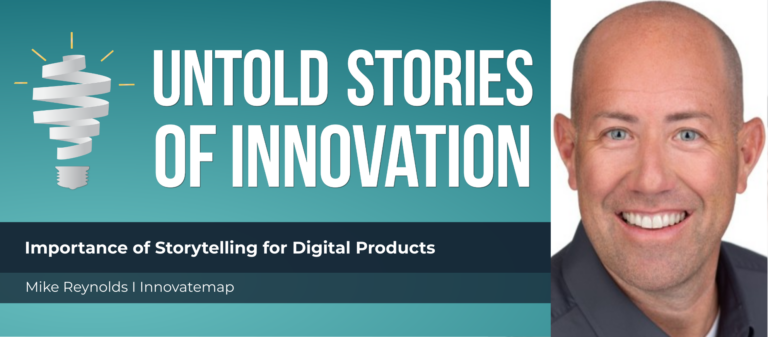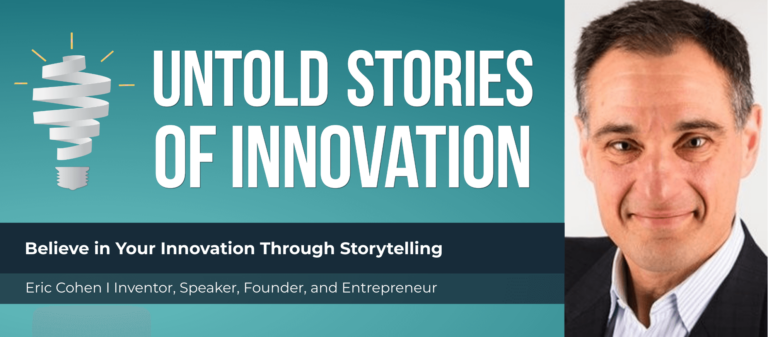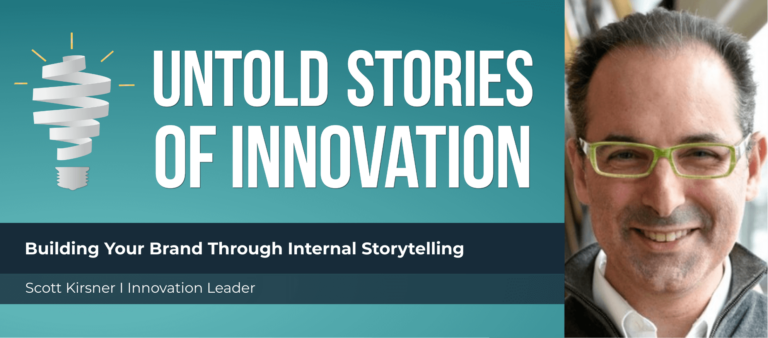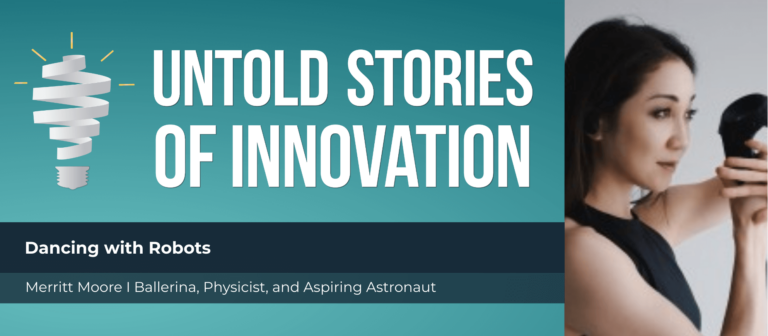Storytelling for Digital Products with Mike Reynolds of Innovatemap
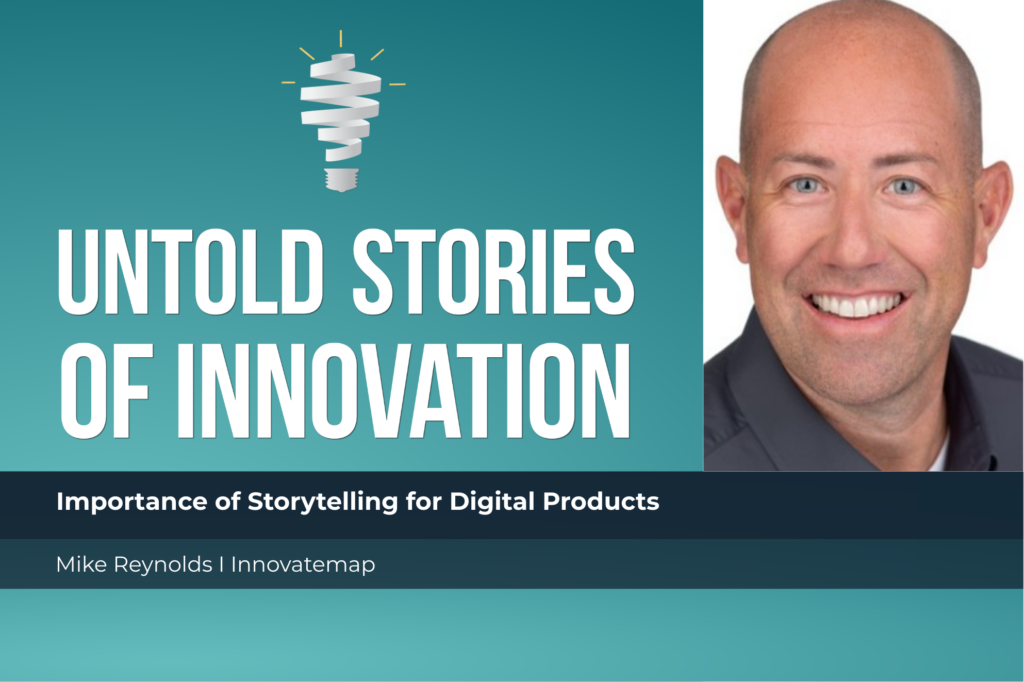
Storytelling for Digital Products - Untold Stories of Innovation
“I don't see the most successful visionaries getting by through followership alone, but by conveying that vision with stories versus focusing immediately on the nuts and bolts of their idea.” — Mike Reynolds
From today’s episode you’ll learn:
Why do stories matter to the innovation process? What values can be instilled with storytelling for digital products in innovators who share stories? How do innovation leaders inspire creators to tell and share their success and failure stories?
We speak with Mike Reynolds of Innovatemap about the ways he uses storytelling for digital products to create successful marketing campaigns. Mike discusses the ways all types of products, from simple commodities to technical services, can harness storytelling to communicate with their customers on an emotional level. Mike also gives great advice on the ways leaders can integrate a unifying vision into their organization by utilizing storytelling.
Mike Reynolds LinkedIn: https://www.linkedin.com/in/mike-reynolds-8594932/
Mike’s BetterProducts Podcast: https://betterproduct.community/podcasts/

Mike Reynolds is the CEO of Innovatemap. Innovatemap is a team of experts in digital product research, branding, marketing, and design that strives to find the deeper story behind every product. Mike has been ideating and delivering digital products to market for over 20 years. He is considered a visionary in the digital space specifically in the areas of Product Management, User Experience and Product Marketing. With a passion for great products and helping other companies achieve it, Mike founded Innovatemap in 2014. Today he leads an exceptional roster of sixteen of the Midwest’s best product professionals. Innovatemap has helped over 150 clients dream, design, and scale more marketable, valuable, and usable products. Mike serves as a formal advisor to many of Innovatemap's clients.
This episode is powered by Untold Content’s innovation storytelling training. Increase buy in for your best ideas in this immersive and interactive, story-driven experience. Where your teams refine storytelling techniques for their latest projects, prototypes and pitches—and get inspired by 25 epic examples of impactful innovation stories. Learn more at untoldcontent.com/trainings/innovation-storytelling-training
Katie Trauth Taylor: Welcome to Untold Stories of Innovation, where we amplify untold stories of insight, impact and innovation powered by Untold Content. I’m your host, Katie Trauth Taylor. Our guest today is Mike Reynolds. He is CEO of Innovatemap. He leads a team of experts in digital product research, branding, marketing and design who’ve helped over one hundred and fifty clients dream design and scale more marketable, valuable and usable products. I’m so thrilled to talk to you today, Mike, about storytelling, especially with regard to product design.
Mike Reynolds: It’s great to be here. Thank you for having me.
Katie Trauth Taylor: And boiler up.
Mike Reynolds: That’s right, by the way.
Katie Trauth Taylor: Yeah, I did my graduate studies at Purdue. And I see that you were a fellow boilermaker.
Mike Reynolds: Always a boilermaker. It’s great.
Katie Trauth Taylor: Shout out to anyone listening who knows what we’re talking about. So Mike, I would love… could you give me a little bit more? I’ve been following Innovatemap; our team at Untold is really thrilled about researching and seeing some of the work that you do. But could you give us, from your perspective, what types of work do you do at Innovatemap, specifically with regard to innovation?
Mike Reynolds: Yeah, it’s great. So real quickly, we describe ourselves as a digital product agency and just unpack the digital product world: very focused specifically on applications, SAAS software, any type of portal, ecommerce, anything that’s basically digitized. Our team is going to be partnering with either the founder or the leadership team behind it, complement them with core skills of strategy and design. So kind of our value prop[osition] is you’re going to build the right thing and it’s going to resonate with a buyer and resonate with the user. And kind of the way we get that done internally in our end is we’ve got seasoned product managers and product designers that are going to get the digital component of it right in terms of the actual product. And then we’ve got a team of branders and product marketers who are going to help tell that story well internally and then eventually to the target market. And so, yeah.
Katie Trauth Taylor: Yeah, so let’s dig in specifically to storytelling and the way that it shows up, you kind of framed it. This is something I hear a lot on the podcast that most organizations sort of have technical R&D innovation, folks alongside marketing, branding, commercial folks. Is that how you structure it to where it’s… they technically… it’s technically people wearing those different hats, but they’re collaborating together.
Mike Reynolds: Yeah. And it’s funny, we’re exclusively the strategy and design competencies and we will partner with the likes of the idea, whether it’s a founder, whether that’s a leader in a larger organization and their technology team of choice. And then it’s funny by design, since day one, I think that we have found that people know that with any of these digital ideas, they need it coded that would, I guess we found and kind of was even the inception of the company was what was really going to differentiate their product isn’t just that it’s well built, on the technology team for things like is it architected well, stable, scalable, integratable. But what’s really going to set that product apart is, is it marketable or is it something that is going to resonate with its market is valuable. Is it solving the stories and the user problems that it intended to? And then is it usable itself? And that’s not typically what the engineers are focused on. And so we will come to the table to complement that very core and fundamental differentiator with that. So I do see the separation of roles and I’m starting to see where that’s almost like this group, technology group, very much focused on, you know, are we building the thing right, while this group is very much focused on are we doing the right thing? And the right thing certainly originated and leveraging storytelling throughout. So that’s kind of where our value really comes into play.
Katie Trauth Taylor: Yeah, that makes a lot of sense. So I’d love to hear from your perspective after working with all of these innovation teams, what is the role and the power of storytelling, especially as you’re trying to, as you said, make sure that you’re building the right thing?
Mike Reynolds: Yeah, my mind goes to several places, honestly, in that face, like for starters. I believe the storytelling is even essential to describing the problem to be solved before you even gotten to the idea. Like what? I think a lot of the digital ideas that don’t even have a unique workflow or user story that they’re even solving. So I would say even just from origin of idea, I understand the story that you’re trying to solve is very important. But I would say, should someone have a vision whether that started, you know, solving a problem or whether you were… had a vision of something of a problem to be solved, it is paramount to convey that vision. I don’t understand how the better way to put it is. I don’t see the most successful visionaries getting by through followership alone, but by conveying that vision with stories versus focusing immediately on the nuts and bolts of their idea and certainly not the science of the idea. And I’ll kind of packed it, too. I mean, followership is you’re going to have to, if certain that you’re a startup tech or even if you’re an entrepreneur or innovation area of a company, people are going to have to buy into your vision. And you’re kind of explaining that with storytelling is what I found being the most engaging way to get people behind your idea. And then the other one being just getting a stakeholder, whether that be, you know, pitching your idea to venture capital or pitching that idea internally to get internal budget support. Once again, I find most of the most successful entrepreneurs are doing so in a way that’s telling the story, the best pitch decks or the best internal social innovation that I’ve seen in a business story. And that’s really just even describing the value of it. And instead of an idea and certainly there’s more I could go into, at least what we see is the idea is be built or being launched and so forth. But that to me, it starts right from the get-go.
Katie Trauth Taylor: Yes, right at that moment, setting up the vision for what should happen. And that really that story seems most effective when it’s strategically aligned, aligned with the brand, the organization, ideally, even the entire innovation ecosystem, whether that’s what’s your industry is most striving to achieve for the future, whether that’s your sort of regional or city level rallying cry, but definitely to at that individual level. I love how you said that storytelling can increase your followership and you use the term championship a lot, and innovation. It’s reminding me specifically of… there are some new studies coming out around the one key performance indicators that innovation leaders should be tracking is employee engagement. And one of the things we’re fascinated by and I hope we can conduct a research study on this, as does effective storytelling, especially at the start, the way that you’re describing it. Does it increase employee or innovator, engagement, motivation, followership, however you want to phrase it? And then what kind of ROI does that generate for the innovation process overall?
Mike Reynolds: Yeah, it’s great. I’ll take two quick thoughts that come to mind on that is: one, it’s certainly essential. Buy-in is, I mean, for many, especially if you’re a startup entrepreneur, Buy-in is literally building your team. So it’s essential. But I actually have found that it actually makes the innovation better. And let me kind of give you an example that if the founder and the leader are using those interchangeably, leader might just be someone in an innovation team or with a larger company if they simply just describe the idea, you know, hey, I need to go build this with X, Y and Z. First of all, that’s interesting, but not overly compelling. But also it’s almost like that the innovation is limited to that, versus hey, I see this problem in the market. These individuals are experiencing this pain. I have a solution that I think that if you just start painting the picture and people are kind of born into the actual story and using storytelling, which you’re not only going to find is the idea is not solely beholden to the originator of the idea. Other people can participate then in the ideation because they have a better comprehension of what’s going down. And [00:09:00]I’ve seen this where it’s like the founder is the only one that has the idea, and it’s and they’re only describing it probably poorly what’s in their head. But if they can kind of unpack that with storytelling or kind of describe in much more of a user workflow or use case model, others can participate and say, hey, I get that too. [17.7s] You think about what about and so forth. That additional input we’ve just seen just really strengthens the overall solution, so I actually believe the idea is better if you can get people brought into what’s actually going down or what’s happening with the with the innovation.
Katie Trauth Taylor: Yes, absolutely, it makes so much sense, I’d love to hear. Do you have any stories you can share or sometimes we call them at untold epic examples of, you know, it could even be small moments where you heard an internal client or leader that you were working with articulate a problem in a way that you just watched the people in the room sort of light on fire.
Mike Reynolds: Yeah, I get it. Yeah. I would say it comes to mind very often when some specifically the easiest one I should say is when someone comes to us and their idea is a consumer idea. And the reason that we can connect immediately to that, because I’m a consumer myself, if it’s… if they’re innovation and solving maybe a very highly special problem in a very highly specialized business domain, you know, you want to get up to speed on that domain before you really have an ability to contribute. But I’ll share one, which was: we had a wonderful founder and it was Carrie Griffith and she had an application called “Little Nugget,” has it, I should say, came to us. And it was , you know, if she would have simply described it as I’ve got an app for new moms to capture their baby memories, just give me that. That’s so interesting. But when she really starts to tell her story about herself and her mom experience and the pains that she felt and the know the angst of not being able to capture these and not be able to capture them well, and no means for that and memories being lost. And that is influenced by an app design. And, you know, when she starts to go into the features of the app with how those meant so much to her personally, just a different level. It’s just a different level. And then that one came to me very quickly. In particular, I’m a father of children as well. And I can immediately connect with and resonate with the pain. And I’m brought in immediately not because they simply have an app idea, but because I understand the story and the origin behind the problem we’re trying to solve with technology. It’s a very different. I said in that instance, if you can’t go back to the original things we were talking about, I’m a stakeholder or I’m a I’m an audience and that in that in that moment and she very rapidly was able to get me to comprehend, buy in and, you know, and do so and totally did so in a way about, you know, sharing real experiences and telling in the story format.
Katie Trauth Taylor: It’s beautiful, and it’s so obvious that the consumer needs to know that story, the investor needs to know that story. If that’s an Intrapreneurship example, leadership and other organizational stakeholders need to hear it. I would love to. I guess in this episode, I’m just dreaming about research studies that we should do together. That’s what I’m doing. But in my dream world, we would research whether when an engineer or a technologist is told the innovation is given their technical brief through story. It would be so interesting to see if that changes anything about the way that they innovate against that problem and build the features and that sort of thing.
Mike Reynolds: Yeah, no, I agree. I agree. I think we use a housing analogy a lot of times for what we do like we know. And just simply because they’re strategic or they’re outcome minded or business led and they’re design led. And I couldn’t imagine if someone just went, you said, I’m building a house two by fours just spewing out measurements versus the hey, I’m building a house I intend to live in forever. I’ve got, you know, this level, this age of children, and this is how they play and how they work. You would need it even just in the 10 seconds I was sharing. It can start to paint a picture in your head of what may be the right product or innovation would be A versus B limit the immediately limited to the implementation of it.
Katie Trauth Taylor: So true. And it’s resonating to me, to everything we know about design led innovation, about user experience, all of those best practices. Really, one of the major differences is the use of storytelling compared to maybe traditional ways of developing technology based on requirements and features.
Mike Reynolds: Yeah, and it’s funny to you know, I would say in this day and age, if you’re not, the majority of digital products are done in a much more agile fashion than Waterfall. And with that sort of production of the digital products, you’re literally the best practice going forward is there are no such things as requirements. It’s user stories. People are building off user stories, not building on hard technical requirements. No, it’s certainly just to kind of that’s literally how it’s done. Now, the hard technical requirements come into play, but they come into play after the story. So if you’re kind of conveying the desired product, even in the depths of how it’s being built, the stakeholders, the product people, the business analysts, they’re the best practice nowadays is to craft those and user stories. And those will translate into technical requirements. But the better products are being read that way. And certainly you and I, to me, that’s a fascinating one where I say, like in our world at least, there is no such thing as a requirement. It’s a user story. And that’s actually what drives the internal processes to actually get that built.
Katie Trauth Taylor: Yes, absolutely. It’s so cool, one of the things that we’ve been doing at Untold lately is we’ve spent the last year asking thought leaders like yourself and innovation leaders like yourself, why does storytelling matter to innovation? And we never heard a single person say it doesn’t. And so at this point, we’ve been shifting over the last several months to really focus on: how is it done? Well, how can you train innovators to do this more effectively? Leaders to do it, technologists, engineers and of course, commercial folks already have some training usually. But what’s the role across the entire process from ideation to market launch and how do you empower people to do it? Well, and what are sort of these, like validated or vetted tools for doing that? And two things you’ve already mentioned. We recently sort of mapped at Untold as we’re building this sort of toolkit of strategies. And it’s one of the things that we are identifying for this toolkit is innovation story patterns. So what are those storylines and plot lines that we hear over and over to the point where we expect to hear them in specific innovation contexts? So you mentioned one that we’ve called the origin story, sharing the origin. And your story about little nugget sharing the origin is that plot line where we sort of hear how an idea was formed, why it mattered on a personal level to the team or the individual who came up with it and how that and how you can use that plot line to really connect deeply on a personal level. And the second one, you were just talking about gathering user stories as part especially of the design sprint or the other innovation. The design sprint user testing is extremely important and that part of your stage game mining for insights is what we call that story pattern, where these are low fidelity narratives. They are pithy but deep insights into what a person feels or experiences. And in a way that those stories are then always utilized to help innovators build the requirements or build the solutions around. So mining for insights and then sharing the origin are two patterns that we’re hearing a lot. And we’re starting to sort of document these patterns and build this toolkit so that people can really be empowered and trained to observe this and hear it rhetorically and their ears be able to listen and know when, when and how these story patterns are used across the innovation process.
Mike Reynolds: It’s great. And I mean, it’s totally aligned with what we see. And honestly, again, I think it’s building a better product and it’s better the innovation will be better. It’s funny for me to think about in my career. I’ve been in digital products for 20 years with the first 10 years certainly being an installable client server software where you were literally guessing. You’re going to build something and hopefully get feedback later. And if I think about just how this has revolutionized better innovation, that it’s being influenced by actual user stories and usage and insights and feedback, the product is just better. And, you know, versus, hey, we built this. Does anybody want this? Do we get it right? You can as you can minimize that risk much earlier in the process.
Katie Trauth Taylor: Yes, yes, yes. So true. Awesome. So I would love to hear you… You seem to have this incredible team that are highly motivated. And I would just love to hear some more stories about some of the innovation projects that you’ve worked on, the way a story has showed up within those processes.
Mike Reynolds: Yeah, and probably I’ll be very honest, the biggest thing we’re seeing now is really that you can we talked about origin of the idea, get by and get a socialization and then you almost assume when it’s funded. Now you’re leveraging it in the insightful area of life where you’re breaking down features and getting that developed. Where we’re seeing it off the charts right now is on the outbound in March. Yes. And I would say that every candidate represents almost half or probably half of our business, which is: you can translate to half the time our clients are asking us for help. And it’s… they built something that they feel is as well. But now they’ve got to bring it to market and sell it, you know, and there is no better way to convey the value of the product to a target market, to a buyer than using the storytelling as well. I mean, gone are the days where I think the product sells itself simply based on how well it’s engineered. Know, I very rarely are we seeing successful products sold just by geeking out on the technology. It’s almost an expectation that it’s well built. Yes. And we’re finding the best sales enablement solution, the best marketing approach. Those are being equipped with exceptional product marketing. And that product marketing is really describing the features or describing the products value or the innovations value totally in stories and imperative for highly technical products. By the way, you can kind of picture a couple of examples. We get a lot of these examples as well. It could be innovation in the highly technical space, like data analytics or Iot Internet things or cybersecurity. You know, if someone described your innovation there, you’re going to be most effective by describing the problem it solves and telling stories about how clients or customers have seen success with it versus just vomit down a list of technical requirements or goodness. So I just say that that’s a very hot thing that we’re seeing now in terms of where a lot of the stories that are coming in are either highly technical products that can’t convey it to a buyer. Help us sell this. And we’re I’m just telling you, our go-to is using stories, you know, or certain or it could be a very easy to understand product in a very crowded space like a lot of these consumer plays, like the example I mentioned earlier about a ”Little Nugget.” There are a lot of apps that store baby photos. Her story cuts through the noise and captures people at the heartstrings. And she’s just done a phenomenal job. But that’s a great example of going to market is imperative that we know in stores it’s really going to differentiate you, especially when a lot of the technology side is commoditized.
Katie Trauth Taylor: When it comes to and, you know, we oftentimes define story more broadly than just that sort of user or customer story. But I think in this case, we’re going to lean into when you say story, you’re specifically talking about someone’s life being changed in light of a product or service and really telling that sort of on a personal level. Right. Which I love. Yeah. Let’s dig into this a little bit. So I just wanted to define that quickly, because I know when we say story, we do mean typically when we’re talking about it here, we mean it to encompass all different types of stories from like the strategic narrative of a leader to product descriptions that are really vivid or use metaphor in interesting ways. So, but yes, user stories and of course, founder origin stories are also critical. I would love to hear what kinds of strategies are working when you watch sort of what could you… could you bring some of this to life for us in terms of what kinds of user stories are you recommending to your clients? Which ones seem to be really resonating with different markets?
Mike Reynolds: Yeah, I would say that the couple that come to mine are narratives, emotions, you know, I use it, I use it. I’m going to call this an innovation. We were probably the business process behind is more innovative than the actual product. But if you were to think about cash for mattress, for example, they’re…the way they describe their product to get people to buy in is not by describing how great of a mattress it is, you know, in the springs and so forth. They’re talking about telling the story of how it can be delivered to you and you’re going to get a better night’s sleep. And that’s kind of I’m going with the really tugging on emotion and using the narrative much more than a hard technical requirements or details. So you and I would say it’s very important to narrative is one narrative is one where we see people a lot of times be very effective when their audience is not familiar with the business. So maybe I’ll give a couple of examples that comes into play. You know, a lot of startup ideas see a problem in the market. It could be, hey, I’m a surgeon in health care and there’s this pain that we have in our world. And here’s the idea I have for it. Well, not everybody is in the operating room with that surgeon understands that. Right? And so they can’t immediately go to talking about the solution if people aren’t familiar with that experience. Right? And this is actually a real example of a client we had and someone they had. They’re not going to get anyone to comprehend the idea if they don’t first paint a picture, which is a great word that will often use the people to kind of draw out the narrative is like paint a picture to me of the problem that’s going down versus, you know, and that starts to add richness, texture, color, literally, and that’s going to help narrow that gap to conveying the innovation.
Katie Trauth Taylor: Yeah, absolutely. No, that’s a great example. Yeah, I’d love to know, too. What do you see as the ways of collecting these types of stories? I mean, that story you just shared is one of the innovator kind of digging deeper and honing their craft of being able to visualize, you know, the problem for others. And then when it comes to painting pictures of a product, changing someone’s life and that sort of thing. Yeah, I’d love to know. Like, it seems like story collection is still a pretty manual process for a lot of marketers and innovators.
Mike Reynolds: Yeah. And I’ll just tell you my reaction to it. I’m very comfortable that it is manual. And when I think about story collection and this is a very prominent take away, it’s much more qualitative research than quantitative. You know, to get these stories. You’re not sending surveys. The questions you’re not trying to answer this point aren’t how often and how many that has its place in time, probably later as you’re maybe trying to validate its conversations. You know, it could be open-ended conversations. We find a lot of the gold, if you will, can be had with conversations with you as your story collection could be potential users. It could be potential stakeholders. It could be rounded out, which is asking them, you know, tell me about this workflow or why don’t open ended questions, what are some of your unmet needs? Imagine a world of that kind of stuff. So I have a story collection I would say is in conversations with open ended promise. Yes, really workflow minded. I’ll just be honest. It’s we’re not you know, I think if you can kind of get at the heart of the way it is and jobs to be done and into a conversation, you’re going to kind of really start to understand unmet needs and desire to stay. And a lot to me, a lot of innovation comes from unmet needs and desired state, because if they were met and existed today, it probably would reflect the product of today. So we’re talking about an innovation. We’re talking about technology or products that are really coming to market to meet a need that is unmet. And I think it’s a kind of we find it much more powerful to get at those unmet needs by having a user tell us about how they’re doing something right now or a way that they wish they were doing something. And that’s not going to be done in a highly automated fashion. So a lot of the manual qualitative conversation is. Is where we get a lot of the gold and, you know, I’m not saying quantitative research has tremendous, tremendous value at different points, depending on your research gold. But if you’re in the story collecting fees, I’m extremely comfortable with, you know, the conversations in the manual, you know, ways to get at that.
Katie Trauth Taylor: Yeah. So it’s kind of like that the process makes the results worthwhile. Yeah. It’s a qualitative researcher in my heart is singing it. What you’re saying is right. And I’m still also fascinated by how we scale up story collection better and do it in a way where insights are getting pooled. And so anyhow, that’s another research area of inquiry for sure. Well, I would love this has been an incredible conversation, Mike. I’m so grateful that you made time to be on the podcast. Would you like to leave us with any additional advice?
Mike Reynolds: Yeah, I would say we… I mean, at the end of the day, what we’re starting to see is the best innovation. And this is certainly rooted in design thinking, but it’s outside and it’s not inside out. It’s… the more that you can understand. I mean, if you think about what’s the right approach to the product, understanding that the story is to be solved, the research will get it, that that’s going to influence the right approach to the product. And then I would recommend that again, an outside in approach to how you go to market. It isn’t just about telling the world what you build. You’ll be more effective if you understand why someone buys it, the pain that they feel and crafting your go to market messaging in that way as well. So definitely outside is maybe the kind of leading thought I’d love to have to share with the audience.
Katie Trauth Taylor: I love that. And it applies to everything we discussed from the early ideation phase all the way through to the marketing launch of the product. So I love that we ended on that note, Mike, where can our listeners follow and find you out in the Internet world?
Mike Reynolds: It’s great. Two things come to mind. I’m probably most active on LinkedIn, myself, personally, my friends, as well as innovative at the company. We’re very active with the content. We also have a thought leadership platform as well. It’s our Better Productpodcast. So if, you know, you want to follow just general leadership around digital products, it would be under “Better Product.” We’ve got podcasts, we’ve got blogs, and a series of content related to that, and that’s probably the best way to follow us. So thank you for asking.
Katie Trauth Taylor: Absolutely. Definitely. Check out their podcast and I am excited to listen in to it myself as well. And Mike, thank you so much for being here. And I will talk to you really soon.
Mike Reynolds: Sounds great. It’s been a pleasure. Thank you.
Katie Trauth Taylor: Thanks for listening to this week’s episode. Be sure to follow us on social media and add your voice to the conversation. You can find us at Untold Content.
